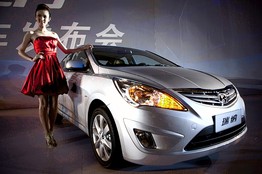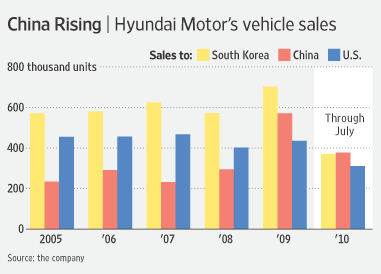Hyundai's China sales near turning point
Hyundai Motor Co., once a laggard in China, is using design to reach a turning point: The South Korean company's sales in China this year likely will surpass those in the auto maker's home market.
 Hyundai on Monday kicked off sales of its new Verna subcompact sedan with a flashy song-and-dance show in Beijing's Olympic Park. The car—priced as low as 73,900 yuan, or about $11,000—is Hyundai's third model with a China-focused design that Hyundai says caters to specific needs and preferences of Chinese consumers, such as roomier interiors and snappier, more chrome-laden exteriors.
Hyundai on Monday kicked off sales of its new Verna subcompact sedan with a flashy song-and-dance show in Beijing's Olympic Park. The car—priced as low as 73,900 yuan, or about $11,000—is Hyundai's third model with a China-focused design that Hyundai says caters to specific needs and preferences of Chinese consumers, such as roomier interiors and snappier, more chrome-laden exteriors.
The Chinese market has become so critical that Hyundai picked China as the venue to roll out the car. Sales in South Korea will begin later this year. Hyundai plans to sell the Verna in the U.S. but declines to say when.
Hyundai's shift is another reflection of China's huge impact on the global auto industry. China's car sales rose nearly 50% last year from 2008, displacing the U.S. as the largest auto market, and the country now is becoming the biggest source of sales for some of the world's biggest auto makers. General Motors Co.'s China sales through July of this year surpassed its U.S. sales, although the China figures include sales of commercial microvans by a joint venture of which GM owns only 34%. GM and other foreign auto makers have also begun beefing up their design capabilities in China.
Once viewed as a low-cost, also-ran in China to more-established foreign brands like Toyota, Volkswagen and Buick, Hyundai is making over of its brand here into a more fashionable, yet affordable, alternative through improved quality and sleeker styling.
The transition has been "a very difficult process," Noh Jae-man, president of Hyundai Motor China, says in an interview. While the fit and finish of its cars is improving, Hyundai still has to overcome a reputation for shoddy quality it earned when the company first began producing and selling cars in China in the early 2000s.
"People had to explain to their neighbors why they are driving Hyundais. A focus on styling has definitely helped," as has improved quality, he says. Hyundai says its five-year/100,000-mile powertrain warranty is a bit more generous than the industry average in China to draw reluctant buyers but not as liberal as the 10-year/100,000-mile offered in the U.S.
 Hyundai declines to say how much it is spending on its China campaign, but a spokeswoman in Seoul says the company's "effort to upgrade our brand image is very broad…we are definitely investing more than before."
Hyundai declines to say how much it is spending on its China campaign, but a spokeswoman in Seoul says the company's "effort to upgrade our brand image is very broad…we are definitely investing more than before."
Hyundai's sales in China took off last year, nearly doubling to 570,000 units and far exceeding the 360,000 the company forecast at the year's start. Hyundai expects sales this year to jump around 18% to 670,000 units, compared with analysts' forecasts for a 15% increase in China's overall passenger-vehicle sales.
Hyundai still hasn't hit the 500,000-unit mark in the U.S., where it has been selling cars since 1986. In South Korea, where Hyundai has roughly a 50% market share, the company's sales range between about 580,000 and 700,000 units a year. Hyundai sold 376,554 cars in China this year through July, compared with 370,295 in South Korea and 309,888 in the U.S.
Hyundai executives say they plan to start construction of a third factory in China, in Beijing, as soon as early next year to keep up with demand, with all output destined for China. The company, which started selling cars in China in 2002 in a venture with government-owned Beijing Automotive Industry Holdings Co., is set to produce nearly 700,000 cars this year at its two factories, which also in Beijing. Mr. Noh says Hyundai hopes to get the third factory running by the middle of 2012, which would boost capacity by another 300,000 cars a year.
Editors' Deep Dive: Auto Makers Focus on China
Hyundai's design strategy is winning over Chinese consumers like Wang Tianyong, a 35-year-old software sales manager in Beijing. Mr. Wang bought his first car two months ago: a new silver Hyundai Elantra Yuedong. He passed over similar cars from Toyota Motor Corp. and Ford Motor Co. The Elantra, for which Mr. Wang paid 86,000 yuan, "looked very stylish, with its modern, exterior design," he says. "The interior is very spacious and trendy, and it is also comfortable to drive."
Hyundai's typical focus on small, fuel-efficient cars has helped its sales around the world, where the shaky economy and high gasoline prices have made consumers more frugal. The company says 77% of the cars it sells in China have engines of 1.6 liters or smaller, while Toyota puts 25% to 30% in that category.
Hyundai was one of the few manufacturers to increase sales and gain market share during the global economic downturn. The company's approach proved especially effective in China, where the government issued incentives to encourage sales of smaller cars.
And Hyundai's Mr. Noh believes the "fluid" and "emotional" design of cars like the Verna will give it a leg up over time—and help Hyundai sustain its momentum in China this year even if sales slow in the second half.
The Verna contains some of the same design characteristics, including pronounced creasing on the doors known as "character lines," that Hyundai has drawn on to transform its stodgy image and boost sales in the U.S.
Hyundai and its smaller Kia Motors unit "are successful in their appeal to customers who appreciate a solid value proposition, balanced with enough emotional design content," says Marek Djordjevic, a former Rolls-Royce senior designer and an instructor at the Art Center College of Design in Pasadena, Calif. "They have done that job so well that people no longer need to make any excuses for their choices."
Mr. Noh also has been retooling some traditional sales approaches. Usually when an auto maker redesigns a model, the old version is discontinued and sells the updated one exclusively. But Hyundai, like some rivals, keeps building and selling older versions in China. The Verna is a replacement for the Accent, but Hyundai plans to keep selling the Accent in China. That's because of China's diversity, with customers in some provinces and regions only able to buy less-expensive cars, while those in wealthier areas like Beijing and Shanghai want the latest models.
"This type of parallel sales…could be a barrier to raising our brand image," says Mr. Noh. "But as a latecomer to the Chinese market, our objective right now is to raise our brand awareness.
Gasgoo not only offers timely news and profound insight about China auto industry, but also help with business connection and expansion for suppliers and purchasers via multiple channels and methods. Buyer service:buyer-support@gasgoo.comSeller Service:seller-support@gasgoo.com







